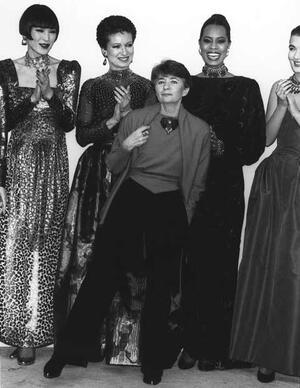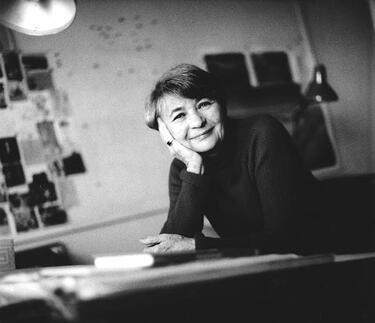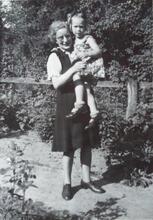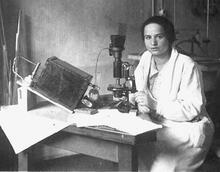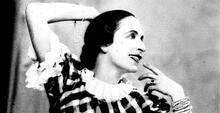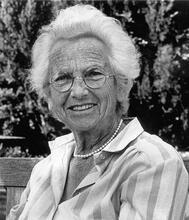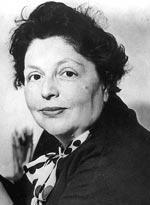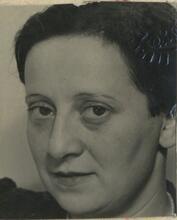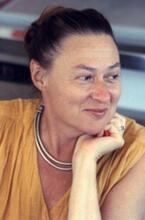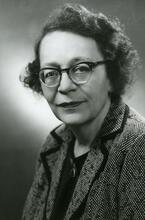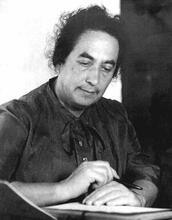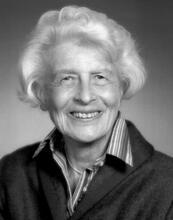Lucie Porges
Lucie Porges brought a combination of elegance and a relaxed sensibility to her long and fruitful collaboration with top fashion designer Pauline Trigère. Porges and her family fled Vienna in 1938, making their way to Switzerland, where Porges studied art. She later moved to Paris and worked under several couturiers while drawing for the magazine L’Art et La Mode. After marrying and moving to New York, she met fashion queen Pauline Trigère and began working for her, eventually becoming a fully fledged collaborator. Porges also earned praise in the New York Times for her independent work. After Trigère’s retirement, Porges taught fashion at the New School for Social Research, in addition to opening a joint exhibition with her husband in Vienna called “Style and Humor.”
On May 30, 2000, Lucie Porges, together with her husband, Paul Peter Porges, received a noteworthy award of distinction from the Municipal Cultural Committee of Vienna. The same evening, the Jewish Museum in Vienna launched an exhibition entitled “Style and Humour: Lucie and Paul Peter Porges.” It was an important and joyous event in the life of the Vienna-born fashion designer from New York. But the prelude to the exhibition was complex and less joyous. Only three months before its opening date, the Conservative Party had established a coalition with Jörg Haider’s Freedom Party (FPOE). Later, in an interview in the New York Times, Lucie Porges said she had actually reached a decision to decline the invitation to the exhibition. “At first I thought I can’t go back and be honored by the city that chased me out and killed my grandparents. But then I thought about all the young friends we have made here, none of whom want Haider. And I thought: Why let him ruin it for the rest of us? I feel this show is rounding out the circle. A way of showing we have won.”
Early life: escape from Vienna
The circle rounded out by the exhibition began in 1923 in the Viennese suburb of Favoriten, where Lucie Eisenstab was born on November 23, 1926. Her mother Jetty née Rosner (Dorna Watra [Vatra Dornei, Romania], 1898–New York, 1990) who came from Bukovina, was the daughter of a wood-merchant and had five brothers. During World War I, the family emigrated to Vienna, where Lucie’s uncles established small businesses. Lucie’s father, Eisig Eisenstab (Drogobych, 1886–Zürich, 1962) came from Galicia. Until 1935 he was engaged in the Viennese textile trade. “My father’s parents were very religious. My granddad was always going to the synagogue and my grandma wore a shaytl (wig). We used to go there on Sundays and I was always bored stiff. It was there that I started drawing fashion pictures. Women with small dogs, viewed from the front, the feet turned sideways, like the Egyptians. I knew nothing of perspective but I was already drawing clothes. My grandparents had nice paper, usually invitation cards that they gave me so that I could play and pass the time. The paper gave me inspiration.”
In 1938, Lucie, together with her parents and her sister Elfi, who was four years her junior, were driven out of their home in Vienna–Favoriten. Her father was arrested following Kristallnacht. When he was released a few weeks later, the family fled, without visas, via Cologne to Brussels. Later stations on their flight were the south of France, the internment camp at Brens, and Lyon. At the end of 1942 the Eisenstabs succeeded in escaping to Switzerland. With the end of the war in 1945 Lucie entered the École des Beaux Arts in Geneva, where she devoted herself primarily to drawing. Here she also met her future husband, Paul Peter Porges, who emigrated to the U.S. in 1947.
Paris, marriage, and New York City
In 1948, Lucie moved to Paris, where she worked for a number of Parisian couturiers, including Maggy Rouff, and learnt the basic skills of haute couture. At the same time, she was drawing for the magazine L’Art et La Mode and there established contact with all the major fashion houses in Paris. In 1951 she left the city of her dreams for New York, since her fiancé Paul Peter Porges had been drafted into the U.S. army for the war in Korea and could therefore no longer travel to Europe. “America came as a shock to me. New York was a sea of buildings. Everything was cold, huge, hideous and loud.”
Lucie and Paul Peter married in June 1951 in New York City and Lucie introduced herself to Pauline Trigère, “the New York fashion queen with a French touch,” from whom she received her first commission as a designer. “Trigère was a real maison de couture. Practically every year we traveled to Europe to buy fabric in Paris. I did the sketches, but I also organized shows, booked models, chose photographers.”
Partnership with Trigère
In 1956, Lucie gave birth to her oldest daughter, Claudia. Before the birth of her second daughter Vivette in 1959, she and her husband visited Vienna for the first time since they had been forced to leave. Lucie continued to work after the birth of her daughter, developing an equal partnership with Pauline Trigère. While Lucie, in the role of artist in residence and fashion designer, put initial ideas on paper, Pauline preferred to work directly with material on a model. Lucie Porges and Pauline Trigère also complemented each other in their concepts of fashion: Trigère specialized in sumptuously luxurious evening dresses, while Lucie went in for everyday wear of relaxed elegance.
At the beginning of the 1980s, as a result of several of her exciting designs, the New York fashion scene “discovered” Lucie Porges independently of her partnership in the Trigère house of fashion. In 1982 the New York Times prominently featured an orange coat she had designed in its Fashion supplement, terming it “The Dashing Coat.”
Independent career
In 1994 the aging Pauline Trigère closed her fashion house. Lucie Porges continued to design, while also imparting her immense knowledge in the Fashion Department of the New School for Social Research.
In 1998, Lucie and Paul Peter, who had a long career as a cartoonist for the New Yorker, began collaborating on a joint exhibition at the Jewish Museum in Vienna, entitled “Style and Humor.” Despite Jörg Haider’s election success, the artists went to Vienna and were lauded by the Viennese press. A year later, the exhibition transferred to New York. Here political events once again impacted on the opening celebration, which was to have taken place on September 11, 2001 at the Hebrew Union College. In fact, it took place on November 23.
Porges passed away on June 17, 2011, at the age of 88.
Hanak, Werner, Style and Humor. Lucie and Paul Peter Porges. Exhibition catalogue Jewish Museum Vienna (2000).
Willis, Marry Pleshette. “Two Who Fled Austria in Terror Return in Triumph.” NYTimes. July 13, 2000.
Friedmann, Jeanette. “Designing Women. Pauline Trigère and Lucie Porges of the House of Trigère.” Lifestyles, 1992, 34–39.
Nüchtern, Klaus. “Fallschirme in Floridsdorf. Ausstellung Lucie und Paul Peter Porges im Jüdischen Museum Wien.” Falter, Nr. 22, 2000, 20, 57–58.
Freund, Michael. “Was ist Wohlfühlen?” A portrait of Lucie and Paul Peter Porges. Der Standard (Album), June 3, 2000, 1–2.

